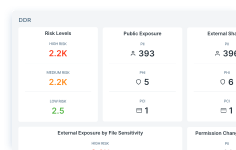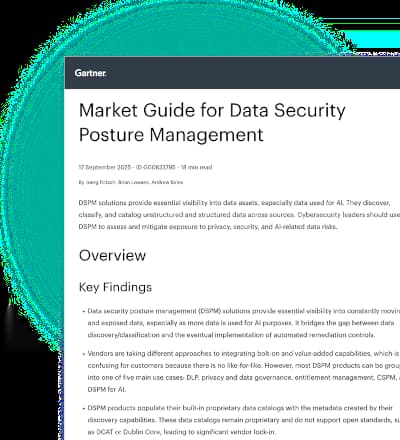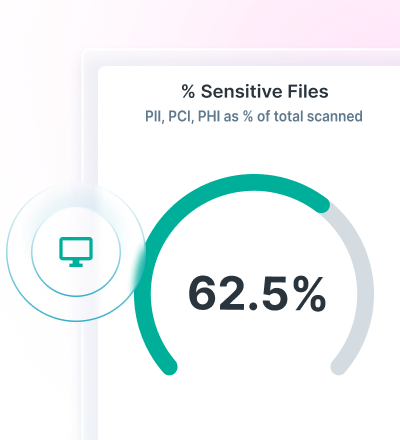Analyzing Data Risk with DSPM
0 Minuten Lesezeit

Lionel Menchaca
Chief Data Officers and data operation leaders are under constant pressure to ensure data is not only protected but also governed in full alignment with global privacy regulations. Cutting through false positives is key to driving efficiency across SOC teams. What they need are clear, actionable insights that show where sensitive data resides, how it is exposed and who has access.
Forcepoint Data Security Posture Management (DSPM) delivers this visibility across cloud and on-prem environments. It goes beyond surface-level detection by quantifying risk across your organization’s data posture. The platform identifies sensitive information such as PII or intellectual property, where those files are stored and whether they have been improperly shared or exposed.
All of this risk analysis is done within the context of compliance frameworks like GDPR, CCPA and HIPAA. Executive dashboards provide a clear picture of trends, exposure levels, and areas requiring immediate attention.
This level of intelligence allows data and privacy leaders to enforce governance policies, ensure audit readiness and actively reduce regulatory and reputational risk.
Uncovering and Assessing Data Risk
Understanding your organization’s true data risk begins with visibility. Sensitive data is often stored in disconnected systems, shared externally without oversight or left unmanaged as redundant, outdated, or trivial (ROT) data.
Our research shows that up to 80% of enterprise data is ‘dark data,’ information that’s invisible to IT and unaccounted for in risk assessments.
Forcepoint DSPM is purpose-built to uncover this data across on-prem and hybrid environments using high-speed scanning and deep integrations. As it discovers data, the platform surfaces granular risk metrics:
- Volume of sensitive files shared externally or overexposed internally
- PII and IP files at risk
- Users with elevated access to critical data
- Instances of duplicate or mislocated files
- Data sovereignty violations across geographic regions
This context-rich data risk assessment enables GRC and security leaders to quickly pinpoint high-risk areas, prioritize actions, and meet the evidentiary demands of internal audits and external regulators.
Enabling Scalable, AI-Driven Compliance
Compliance today requires more than just policies. It demands continuous proof of enforcement. Forcepoint DSPM helps teams classify sensitive data accurately and consistently, using AI models trained on domain-specific examples. These models go beyond basic pattern matching to identify nuanced business data like proprietary formulas, contracts, or regulated records.
Forcepoint DSPM’s secret weapon is AI Mesh, a highly networked classification architecture that uses a Small Language Model (SLM) that powers rapid and precise data classification across vast, diverse repositories.
The result? Highly accurate identification of regulated data that includes everything from PII and trade secrets to intellectual property, along with contextual tagging aligned with compliance frameworks like Microsoft Purview.
AI Mesh allows teams to customize models to their unique data types, adapt quickly to new regulatory demands and reduce false positives that plague pattern-based systems.
DSPM also simplifies regulatory response tasks, including:
- Data Subject Access Requests (DSARs) help security teams reply to requests in a timely manner.
- No-code dashboards provide instant views into compliance status across regulations (GDPR, HIPAA, CCPA, etc.)
- Automated alerts notify teams of violations or emerging data exposure trends
With these capabilities, security leaders can shift from reactive compliance checklists to proactive, auditable data governance.
Driving Accountability Through Manual Risk Reduction
After analyzing risk, taking the right action is critical. Forcepoint DSPM empowers security and compliance teams to address issues that demand human oversight and ownership.
One key area is managing access permissions. With detailed visibility into who has access to sensitive files, security teams can quickly spot excessive privileges or outdated entitlements. From there, they can work with data owners to adjust permissions and reduce unnecessary exposure. This helps ensure compliance with least-privilege principles and reduces the risk of insider misuse.
Another important action is relocating or removing sensitive data found to be in the wrong place. Whether it’s proprietary files sitting in unsecured cloud storage or regulated data found in shared team drives, DSPM highlights these misplacements with full context. Data owners or custodians can then move the files to sanctioned locations or apply appropriate protection.
Stay Ahead of Regulatory Requirements with DSPM
Whether you’re preparing for an audit, responding to regulatory pressure or seeking to reduce your attack surface, DSPM offers the insight and control you need.
Talk to an expert today about how Forcepoint DSPM can help your organization understand data risk better than ever before. Or explore a free Forcepoint Data Risk Assessment to benchmark your current posture and take the first step toward stronger, smarter data governance.

Lionel Menchaca
Mehr Artikel lesen von Lionel MenchacaAs the Content Marketing and Technical Writing Specialist, Lionel leads Forcepoint's blogging efforts. He's responsible for the company's global editorial strategy and is part of a core team responsible for content strategy and execution on behalf of the company.
Before Forcepoint, Lionel founded and ran Dell's blogging and social media efforts for seven years. He has a degree from the University of Texas at Austin in Archaeological Studies.
- Expose risk with a free Forcepoint Data Risk Assessment
In dem Artikel
 Expose risk with a free Forcepoint Data Risk AssessmentSign up for a Data Risk Assessment
Expose risk with a free Forcepoint Data Risk AssessmentSign up for a Data Risk Assessment
X-Labs
Get insight, analysis & news straight to your inbox

Auf den Punkt
Cybersicherheit
Ein Podcast, der die neuesten Trends und Themen in der Welt der Cybersicherheit behandelt
Jetzt anhören









